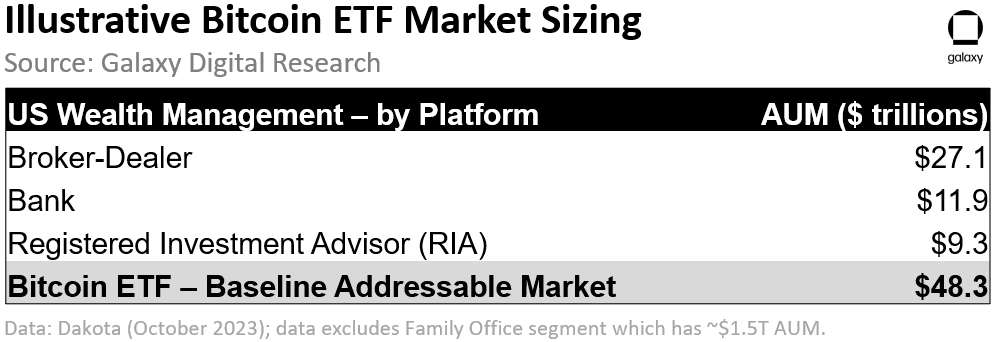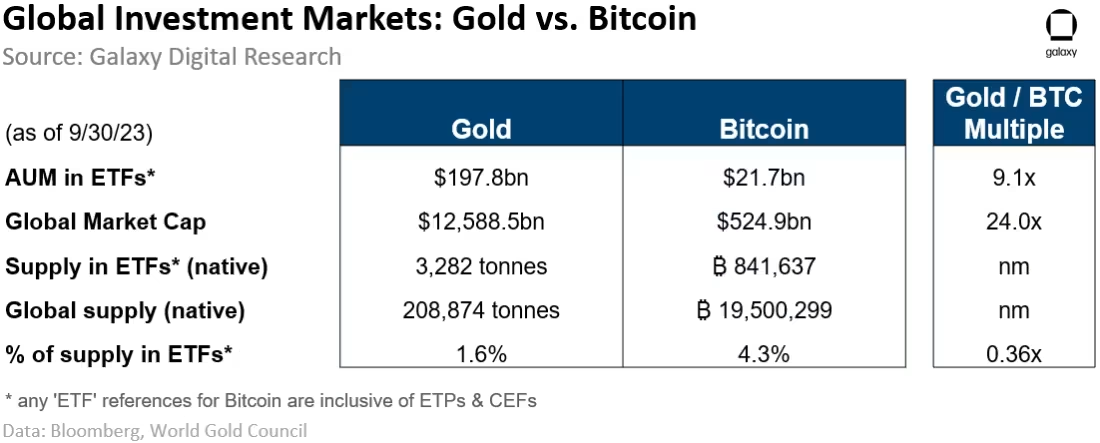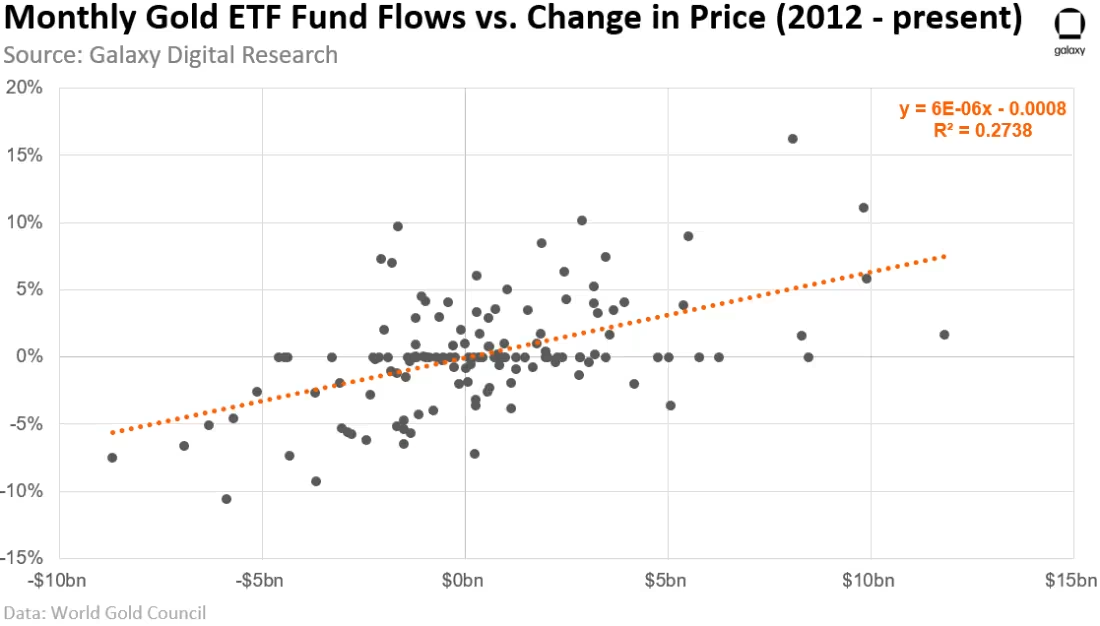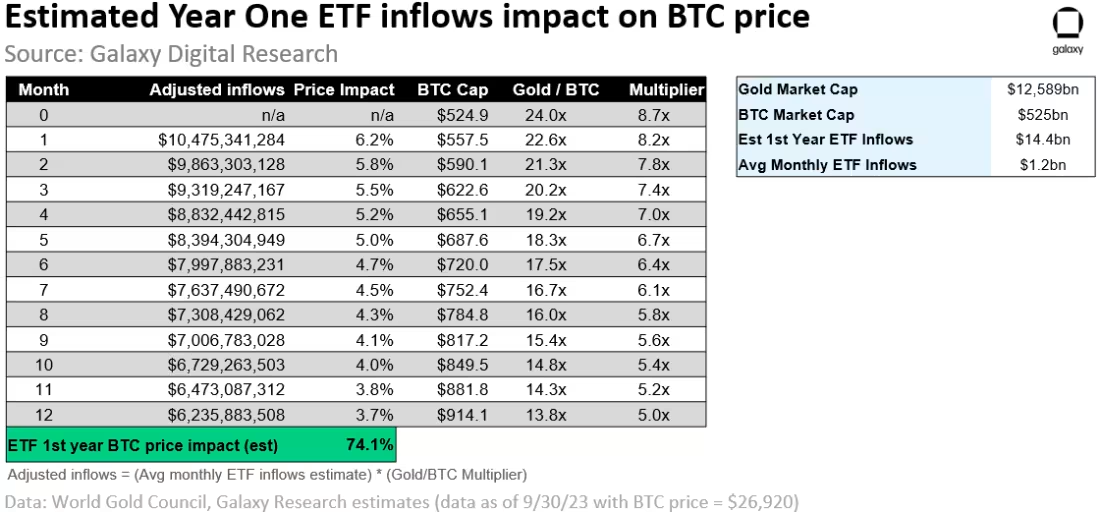Original Title: "Sizing the Market for a Bitcoin ETF"
Original Author: Charles Yu, Galaxy
Translation: Odaily Planet Daily Translator | Nianyin Sitang
The approval of a regulated spot Bitcoin ETF in the United States will be one of the most influential catalysts for Bitcoin (and cryptocurrencies as an asset class) adoption.
Significance of Bitcoin ETF
Why is a Bitcoin ETF a more ideal solution than current investment tools?
As of September 30, 2023, the total amount of Bitcoin held by Bitcoin investment products (including ETPs and closed-end funds) is 842,000 coins (approximately $217 billion).

The drawbacks of these Bitcoin investment products for investors are obvious—aside from high fees, low liquidity, and tracking errors, these products are inaccessible to a significant portion of the investor population representing a large amount of wealth. Other investment options that provide indirect exposure to Bitcoin (such as stocks, high-frequency trading funds, and futures ETFs) also suffer from similar inefficiencies in tracking. Many investors are unwilling to deal with the administrative burden of directly owning Bitcoin, which involves wallet/private key management, self-custody, and tax reporting.
A spot ETF may be suitable for any investor looking to directly invest in Bitcoin without the need to self-custody and manage Bitcoin, and it offers many advantages over current Bitcoin investment products and options, such as:
Improved efficiency through cost, liquidity, and price tracking. While the applicants for the Bitcoin ETF have not listed fees, ETF fees are typically lower compared to hedge funds or closed-end funds, and a significant number of ETF applicants may aim to maintain low fees to remain competitive. A spot ETF will also provide greater liquidity as it can be traded on major exchanges, and it can better track the price of Bitcoin compared to futures products or proxies, thereby gaining exposure to Bitcoin.
Convenience. A spot ETF can provide investors with access to Bitcoin exposure through a wider range of channels and platforms, including a range of established providers that investors are already familiar with. It offers a more accessible channel for both retail and institutional investors compared to direct ownership, which requires a certain level of self-education and higher management costs.
Compliance. A spot ETF may meet stricter regulatory requirements in custody setup, supervision, and bankruptcy protection compared to existing Bitcoin investment products. Additionally, ETFs can provide market participants with better price transparency and discovery, which may help reduce Bitcoin market volatility.
Why is a Bitcoin ETF important?
Two main factors that may have a particularly significant impact on the adoption of Bitcoin in the market with the approval of a spot Bitcoin ETF are: (i) expanding accessibility to wealth segmentation markets; (ii) a greater degree of acceptance of Bitcoin through formal recognition by regulatory agencies and trusted financial service brands;
- Accessibility
Expanding reach to retail and institutional investors. The range of available Bitcoin investment funds currently is limited, including products primarily driven by wealth advisors or offered through institutional platforms. An ETF is a more direct compliant product that will increase investment opportunities for a broader range of investors, including retail and high-net-worth individuals. Unlike reliance on wealth management companies, an ETF can be used by a wider range of clients, including those who cannot directly purchase spot Bitcoin through brokerage firms or RIAs.
Distribution through more investment channels. Without Bitcoin investment solutions like a spot ETF, financial advisors/trustees are unable to consider Bitcoin in their wealth management strategies. Wealth management departments hold significant funds that have been unable to access Bitcoin investments directly through traditional channels— with an approved spot ETF, financial advisors can begin guiding their wealth clients to invest in Bitcoin.
More wealth opportunities. The baby boomer generation and older (59 and older) hold 62% of U.S. wealth, but only 8% of adults aged 50 and older invest in cryptocurrencies, while 25% of adults aged 18-49 invest in cryptocurrencies (data from the Federal Reserve, Pew Research Center). Offering a Bitcoin ETF product from familiar and trusted brands may help attract more older, high-net-worth individuals who have not yet participated.
- Acceptance
Formal recognition/legitimacy from trusted brands. Applications for a Bitcoin ETF have been submitted by a large number of established financial companies— formal recognition/validation from these mainstream companies can enhance people's perception of the legitimacy of Bitcoin/cryptocurrencies as an asset class and may attract more acceptance and adoption. According to data from the Pew Research Center, among 88% of Americans who have heard of cryptocurrencies, 75% lack confidence in the current ways of investing, trading, or using cryptocurrencies.
Addressing compliance issues; regulatory clarity will attract more investment and development. SEC approval of the ETF can alleviate many safety and compliance concerns for investors, as an ETF is a regulated investment product with more comprehensive risk disclosure. It will also provide market participants with the long-term regulatory transparency required to conduct business in the crypto industry. A more developed regulatory framework will attract more investment and development, enhancing the competitiveness of the United States in the crypto industry.
Acceptance of BTC investment portfolios as an asset class. Bitcoin can offer diversified benefits and higher returns to investment portfolios, regardless of where the portfolio's allocation is derived from. To help guide investment management decisions, more retail investors and financial advisors are turning to model portfolios and automated solutions, which increasingly use ETFs and incorporate other asset classes to provide investors with more risk-optimized returns. A longer track record can support the case for using Bitcoin in investment portfolios for more investment strategies.
How much capital inflow will the approval of a Bitcoin ETF bring?
Given the accessibility reasons mentioned above, the U.S. wealth management industry may be the most accessible and direct market, from which an approved Bitcoin ETF will receive the most net new accessibility. As of October 2023, the total assets managed by broker-dealers ($27 trillion), banks ($11 trillion), and RIAs ($9 trillion) amount to $48.3 trillion.

In our analysis, we applied $48.3 trillion as the baseline TAM (total addressable market) within the selected U.S. wealth management consolidators (excluding the family office channel managing approximately $2 trillion), although the target market for the Bitcoin ETF and the indirect impact of the approval of the Bitcoin ETF may far exceed the U.S. wealth management channel (e.g., international, retail, other investment products, and other channels), and may attract more capital inflow into the spot Bitcoin market and investment products.
(Note: While we used a TAM-style analysis to estimate the capital inflow of the Bitcoin ETF, we acknowledge that the funds flowing into the Bitcoin ETF may also drive new net inflows rather than simply transferring from existing allocations—thus, applying a percentage to the estimated TAM figures does not fully capture our view of how the Bitcoin ETF will be adopted, as it does not capture this new demand flow.)
With the opening of channels, the admission cycle of Bitcoin ETFs in these areas may continue for several years. The RIA channel is mainly composed of more seasoned independent registered investment advisors, who may be allowed access earlier than advisors at banks and broker-dealers, so in our analysis, their initial access share is larger. For the broker-dealer and bank channels, each individual platform will determine when to unlock access to Bitcoin ETF products for their advisors—except for some exceptions, bank-affiliated financial advisors cannot offer or recommend specific investment products without platform approval. The platform may have specific requirements before offering new investment products (such as over 1 year of track record or reaching a certain AUM level, general suitability issues, etc.), which will affect the entry cycle.
We assume that the RIA channel will grow from 50% in the first year to 100% in the third year. For the broker-dealer and bank channels, we assume a slower growth rate in the first year, starting at 25% and steadily increasing to 75% in the third year. Based on these assumptions, we estimate the target market size of the U.S. Bitcoin ETF to be approximately $14 trillion in the first year after launch, $26 trillion in the second year, and $39 trillion in the third year.

Based on these market size estimates, if we assume that 10% of the available assets in each wealth channel adopt Bitcoin, with an average allocation of 1%, we estimate that there will be $14 billion inflow in the first year after the launch of the Bitcoin ETF, increasing to $27 billion in the second year, and $39 billion in the third year. Of course, if the application for a spot Bitcoin ETF is delayed or rejected, our analysis will change due to time and entry restrictions. Alternatively, if poor price performance or any other factors lead to lower-than-expected adoption of the Bitcoin ETF, our estimates may be overly aggressive. On the other hand, we believe that our assumptions about investment channels, exposure, and allocations are conservative, so the inflow of funds may be higher than expected.
Potential Impact on Physical BTC
According to data from the World Gold Council, as of September 30, 2023, global gold ETFs collectively held approximately 3,282 tons (AUM approximately $198 billion), accounting for approximately 1.7% of the gold supply.
As of September 30, 2023, investment products (including ETPs and closed-end funds) held a total of 842,000 bitcoins (AUM approximately $217 billion), accounting for 4.3% of the total Bitcoin supply.

Compared to Bitcoin, the market value of gold is approximately 24 times that of Bitcoin, while the supply of investment tools has decreased by 36%, so we assume that the impact of equivalent US dollar inflows on the Bitcoin market is approximately 8.8 times that of the gold market.
If we apply the estimated inflow of $14.4 billion in the first year (approximately $1.2 billion per month, or adjusted to approximately $10.5 billion using the 8.8x multiplier) to the historical relationship between gold ETF fund flows and gold price changes, we estimate that the first month's impact of the spot ETF on Bitcoin's price is +6.2%.
 Keeping the inflow constant, but adjusting the multiplier downwards based on changes in the gold/Bitcoin market value ratio due to Bitcoin price increases, we can see that the monthly return gradually decreases from +6.2% in the first month to +3.7% in the last month of the first year, resulting in an estimated 74% increase in Bitcoin's price in the first year after the approval of the ETF (using the September 30, 2023 Bitcoin price of $26,920 as the starting point).
Keeping the inflow constant, but adjusting the multiplier downwards based on changes in the gold/Bitcoin market value ratio due to Bitcoin price increases, we can see that the monthly return gradually decreases from +6.2% in the first month to +3.7% in the last month of the first year, resulting in an estimated 74% increase in Bitcoin's price in the first year after the approval of the ETF (using the September 30, 2023 Bitcoin price of $26,920 as the starting point).

Broader Financial Impact of ETF on the Bitcoin Market
The above analysis estimates the potential capital inflow into U.S. Bitcoin ETF products. However, the second-order effects of the approval of a Bitcoin ETF may have a greater impact on Bitcoin demand.
In the short term, we expect other global/international markets to follow the lead of the United States, approving and offering similar Bitcoin ETF products to a wider range of investors. In addition to ETF products, various other investment tools may add Bitcoin to their investment strategies (such as mutual funds, closed-end funds, and private equity funds), spanning investment objectives and strategies. For example, Bitcoin exposure can be increased through alternative funds (such as currency, commodities, and other alternative funds) and thematic funds (such as disruptive technology, ESG, and social impact).
In the long term, the target market for Bitcoin investment products may further expand to all third-party managed assets (approximately $126 trillion according to McKinsey's data), and even more broadly to global wealth (approximately $454 trillion according to UBS). Some believe that as Bitcoin becomes monetized, it will systematically reduce the currency premium applicable to other assets such as real estate or precious metals, significantly expanding Bitcoin's TAM.
Based on these market sizes, and keeping our adoption/allocation assumptions unchanged (10% of funds adopting Bitcoin, with an average allocation of 1%), we estimate that the potential additional inflow into Bitcoin investment products will range from $125 billion to $450 billion over a long period of time.

Conclusion
For a decade, applicants have been seeking to list spot-based Bitcoin ETFs. During this period, the market value of Bitcoin has risen from less than $1 billion to today's $600 billion (peaking at $1.27 trillion in 2021). During this time, global Bitcoin holdings and usage have increased sharply, with various types of wallets, cryptocurrency exchanges, and custodians appearing around the world, as well as traditional market access tools. However, the world's largest capital market, the United States, still lacks the most effective market access tool for Bitcoin—a spot-based ETF. Market expectations for the imminent approval of an ETF are rising, and our analysis indicates that these products may see a significant inflow of funds, primarily driven by wealth management channels that currently cannot access Bitcoin exposure on a large scale.
The inflow of funds from ETFs, the narrative about the upcoming halving of Bitcoin (in April 2024), and the possibility that interest rates have already peaked or will peak in the short term, all indicate that 2024 may be extraordinary for Bitcoin.
免责声明:本文章仅代表作者个人观点,不代表本平台的立场和观点。本文章仅供信息分享,不构成对任何人的任何投资建议。用户与作者之间的任何争议,与本平台无关。如网页中刊载的文章或图片涉及侵权,请提供相关的权利证明和身份证明发送邮件到support@aicoin.com,本平台相关工作人员将会进行核查。




